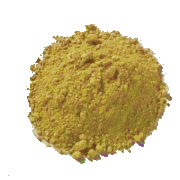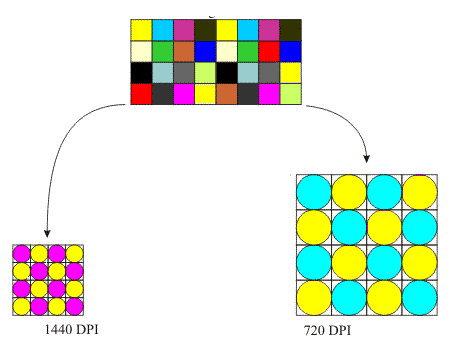The Physics of Colour - Colour Subtraction
When light shines
onto an object some of it is absorbed and some of it is scattered back
into the eye of the observer.
- White objects send all of the colours of the spectrum back into your eye - all three
cones in your eye are stimulated equally so the object is perceived
as white.
- Red objects only send red light into your eye. Therefore only the red cones are
stimulated and you say the object 'is red'. The red object absorbs all
of the other colours.
- Yellow objects scatter both red and green light. Therefore they stimulate the red and
green cones of the eye and the brain recognizes the object as being
yellow. The blue light in absorbed by the yellow object.
Using this information
we can work out what objects look like under different lighting.

Pigments
The primary
coloured objects can only scatter their own colour of light. If it is
not there to be scattered they are seen as black. So if the light shining
onto them does contain that colour they will be seen as it if it does
not contain it they appear black. Therefore red materials always look
red or black (no other colour!). If illuminated by cyan light red will
look black.
The secondary
coloured objects can scatter any combination of the two colours that
make them up - therefore under some light they look as if they are of
a primary colour. Only when illuminated by light of the colour they
totally absorb do they look black. So, cyan objects look black when
seen red light.
Pigments appear the colors they are because they selectively reflect and absorb certain wavelengths of light. White light stimulates each of the three colour cones on the retina. When this light encounters a pigment, some wavelengths are absorbed by the chemical bonds and substituents of the pigment, and others are reflected or scattered into our eyes. This creates the appearance of a colour for the pigment.
 Blue paint pigment (usually nearer to cyan than the deep pure blue) reflects light that stimulates the blue and green cones and absorbs most of the light that would stimulate the red.
Blue paint pigment (usually nearer to cyan than the deep pure blue) reflects light that stimulates the blue and green cones and absorbs most of the light that would stimulate the red.
 Yellow paint pigment reflects light that stimulates the red and green cones and absorbs most of the light that would stimulate the blue.
Yellow paint pigment reflects light that stimulates the red and green cones and absorbs most of the light that would stimulate the blue.
The eye therefore gets a double dose of stimulation for the green cones and only a single dose for the other two. The brain therefore registers the mixture of pigments as green.

When you use a colour computer printer the ink colours are yellow, cyan and magenta (and black). If you print a green object the tiny dots on the page will be of cyan and yellow. Both of these dots viewed in white light stimulate the green cones in your eyes but only the magenta ones stimulate the red and only the cyan ones stimulate the blue. You therefore get double stimulation of the green cones and see the object as green on the page of print. Look at the red object - do you understand why the dots are magenta and yellow?
Links:
- See here for how cameras work
- See here for more detail on how our eyes allow us to see different colours (Advanced level work).
Questions
 Now try some questions on Colour.
Now try some questions on Colour.



 Blue paint pigment (usually nearer to cyan than the deep pure blue) reflects light that stimulates the blue and green cones and absorbs most of the light that would stimulate the red.
Blue paint pigment (usually nearer to cyan than the deep pure blue) reflects light that stimulates the blue and green cones and absorbs most of the light that would stimulate the red.  Yellow paint pigment reflects light that stimulates the red and green cones and absorbs most of the light that would stimulate the blue.
Yellow paint pigment reflects light that stimulates the red and green cones and absorbs most of the light that would stimulate the blue. 




